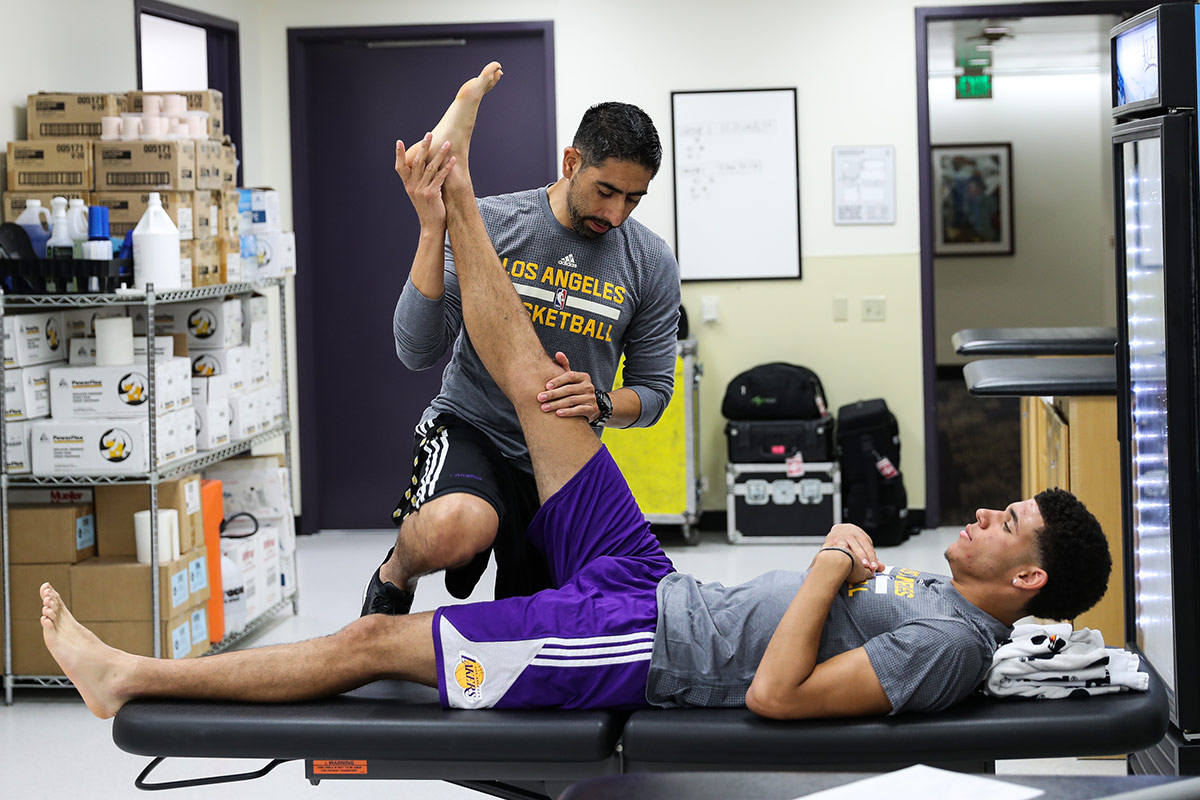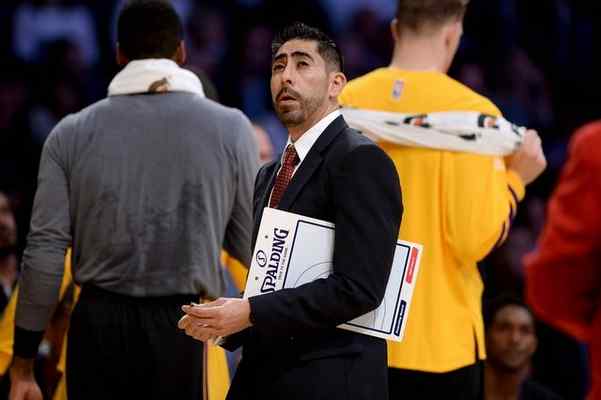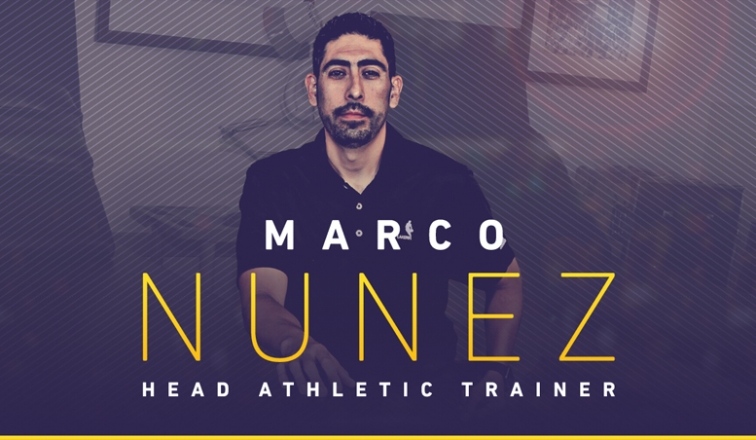
Article reposted from NBA.com
Author: Mike Trudell
Marco Nunez took over the position of Lakers Head Athletic Trainer from Gary Vitti last season and completed a year of generally good health from a roster of mostly young players.
We sat down with Nunez at the tail end of the team’s Summer League experience in Las Vegas to discuss where he wants to devote more focus leading into the 2017-18 campaign, what areas of emphasis he’s circled for the players and how it’s going working alongside new management on the basketball ops side.
Below is a transcription of our conversation:
MT: Where are you at this point compared to when you took over the job from Gary Vitti last August?
Nunez: My role is still continuing as is it has for the last year. The one thing about this summer is it’s allowing me to get my head together and see what I want to implement and begin for the coming season. Last year I took the position in August, and I didn’t really have time to sit down (and think). Getting one year under my belt, I was able to see the ins and the outs, what I like and don’t like, what I want to change or implement. This summer is about seeing what new techniques, new modalities, new units, new programs, new nutrition … whatever it is, I’ll sit down with our staff and figure out what to improve for this upcoming year.
MT: Is part of that sitting down with the new front office and deciding where to put resources?
Nunez: We’ve already done that. We’ve had plenty of meetings with Luke (Walton), Magic (Johnson), Rob Pelinka. Last year when all the changes were occurring, we just wanted to get through the season. Then at the end of the season, it’d be time to figure out what we want to do moving forward. So I’ve sat with them a bunch of times to discuss a variety of things. For example, talking about where we want to add staff members and what we’d want them to focus on.

MT: What’s one area of focus?
Nunez: There are a couple areas we’re looking at, like hiring a nutritionist or a dietician full time. We’ve had somebody in the past that we’ve used that was great, but I know it was almost like a consulting kind of thing. I think we’re trying to decide whether we should make that position full time. I don’t know if that position would travel full time or not, but having them right there at the practice facility where guys can ask questions, and our chef, Sandra, can work with them closely and try to see what we can create for the players could really help.
MT: How about dealing with and anticipating injuries, which is something I know is always on your mind…
Nunez: Exactly, we’re looking at different companies right now. There’s one company we tried out at summer league, keeping track of guys exertion levels, exhaustion levels, sleeping patterns and stuff like that. Everything is going towards technological (advancement), so we’re looking at a company that’s more of an app. These players will go right on their phones the minute a game is over. So the app would ask some simple questions that gives us feedback about how the players are feeling and where they’re at from that perspective. The other thing we’re doing focuses on hydration. In the past, it’s always been, ‘Make sure you’re drinking plenty of water and getting plenty of electrolytes.’ Traditionally there’s the, ‘Hey when you use the restroom, check your urine color, and if it’s dark red or orange, it means you’re dehydrated. If it’s a light color, you’re good’, but we can go deeper than that. I know we’re working with GSSI, Gatorade Sports Science Institute; they came last year and tested most of our guys as far as sweat analysis and to try and create a hydration program for the guys. We’re testing that out in summer league to see how it works. Whether it’s advising how much water and electrolytes to drink six hours before a game, how much during a game and more importantly, after a game this is specifically how much water and Gatorade a specific player needs to consume. Especially on the road and for back to backs. We have to really focus on how our guys are recovering.
MT: How has the way you deal with these young players at Summer League evolved over the last several years?
Nunez: Back when I first started, we’d typically only have one or two draft picks at summer league because we were winning championships. This summer league team is different, with six draft picks that form part of the core of the roster (moving forward). So what we’re doing now and what Luke is trying to do is set a culture that will continue into training camp. Some of these one and done (in college) players aren’t used to having to come into the training room. Having to focus on stretching, on recovery, focus on hydration. We want to start those good habits now, not wait until training camp or the season to start.

MT: What kind of discussions did you have about how much to rest players in Vegas given that, on one hand, they’re young, but on the other, they aren’t used to playing so many games in so few nights?
Nunez: We had conversations about that with the coaches. Traditionally the mentality is they’re young guys, they can play as many minutes as you want. But that’s not always the case. These young guys aren’t used to playing this many minutes, especially on back to backs. You don’t play back to backs in college. Now they’re going to play back to back to back, exerting themselves? Personally I was a little surprised that we’d have guys playing back to backs. Ideally, it’d be nice if they got a Monday off and the game would have been Tuesday, but that’s a scheduling issue. From the sports medicine side, if you’re in the NBA Finals and it’s Game 6 or 7, and all your technology is showing you the player is in the red, are you really going to sit the guy? And there’s a difference between the NBA Finals and the Summer League. My job is to provide them the information and then as a unit, along with management and the coaches, we make a decision.
MT: How about in the example of Josh Hart, the rookie who sprained his ankle and didn’t get back onto the court?
Nunez: That’s my saying, ‘He isn’t really ready to play’ as much as the coaches or management would love to see him play. As much as a player says ‘I’m ready to go,’ it’s my job to hold a player back if I think he’s not. One, it’s summer league, so it’s a risk/reward thing. Does the risk supersede the reward? We’re trying to create a tradition of winning, but it’s still summer league. If it were the Finals, different story. He was doing a lot better after (a few days), and could he go out there and play some minutes? Probably. But the problem was, as far as rehab, there’s a progression that you want to see from 1-on-0, 1-on-1, 3-on-3 and eventually 5-on-5. Since we played so many games, we didn’t have a chance to practice, and Hart didn’t get an opportunity to play 5-on-5 in practice for me to be able to say, ‘He’s ready to go.’ The risk was higher than the reward.
MT: Lonzo Ball came into the Summer League out of his best basketball shape, as he played no 5-on-5 from the NCAA Tournament through the Draft. He said his legs felt heavy early, but he certainly looked better physically after getting the couple days between the second and third game he played. What have you thought of Ball’s physical progression?
Nunez: It wasn’t a surprise he’d be fatigued early after taking close to a month off. But I’m trying to get away from the whole cookie cutter program. Every player is slightly different, it’s never one size fits all. That’s something we’re looking for as we develop these programs and technologies to cater to the individual. You have some players like Kobe Bryant, who could generally play as many minutes as he wanted and be fine. There are others where you can’t make that same assumption.



